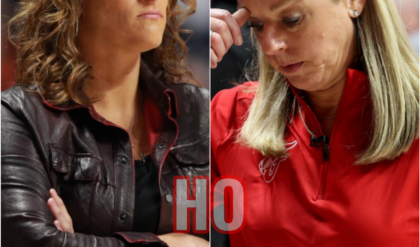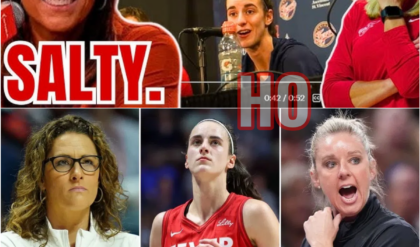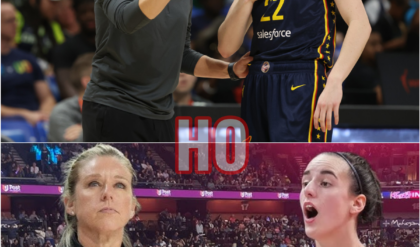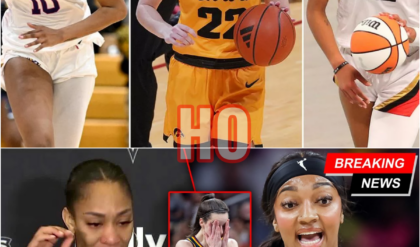WNBA Rating CRASH & BURN After Caitlin Clark Elimination & Bυllies Throw TANTRUM Fit | THIS IS BAD!! | HO

The WNBA has experienced a significant surge in attention and popularity thanks to the arrival of Caitlyn Clark, a transformative player who quickly became the face of the league. The “Caitlyn Clark effect” has been credited with drawing in new audiences and boosting viewership to record highs, especially for her team, the Indiana Fever. Clark’s rookie year electrified fans and created immense buzz around women’s basketball, making her one of the most talked-about athletes in sports. Her impact on the league has been undeniable, with many attributing a significant increase in viewership and attendance to her presence alone.
However, the recent elimination of Caitlyn Clark and her team from the WNBA playoffs has caused a sharp decline in ratings, leading to widespread concerns about the future of the league without its new star player. When Clark played, arenas were packed, and TV viewership soared. In her playoff debut, she drew 1.84 million viewers, the highest-rated WNBA playoff game since 2000. This was a groundbreaking moment for the WNBA, marking a shift in attention and proving that women’s basketball could captivate a large audience.
But with Clark out of the playoffs, the league has been hit with a harsh reality: viewership has plummeted from 1.8 million to just 161,000, an unprecedented drop that raises questions about the WNBA’s ability to sustain interest without its marquee player. This sudden crash in ratings suggests that the league may have become too reliant on one individual to drive its success, leaving fans wondering if the WNBA can thrive without Caitlyn Clark.
The WNBA has long been in a challenging position when it comes to capturing the attention of mainstream sports fans. For years, the league has struggled to garner the same level of excitement and financial support as the NBA, often relying on die-hard fans and niche audiences. The NBA itself provides significant financial support to the WNBA, contributing $200 million annually to help keep the league afloat. Yet, despite this support, the WNBA continues to face difficulties in terms of marketing, fan engagement, and revenue generation.
Caitlyn Clark’s arrival brought a glimmer of hope. She not only delivered on the court but also brought new energy to the league. Her playmaking abilities, combined with her confident and fearless attitude, captured the attention of basketball enthusiasts and casual fans alike. Clark’s 18 points, 5 rebounds, 8.5 assists, and 2 steals per game in the playoffs were the kind of numbers that hadn’t been seen from a rookie in WNBA history. Her performance drew comparisons to Magic Johnson’s legendary rookie season, with some even suggesting that she was entering “Michael Jordan territory” in terms of her impact on the sport.

Unfortunately, the WNBA’s failure to capitalize on her momentum has now left the league in a precarious position. With Clark no longer in the playoffs, the excitement surrounding the league has waned, and empty arenas and dwindling TV audiences are becoming more common. The Indiana Fever, once a team that few paid attention to, became a major draw thanks to Clark. Now that they’re out of contention, the league is facing a steep drop in interest, and it’s clear that the WNBA’s over-reliance on Clark has exposed deeper issues.
Moreover, the WNBA’s playoff format has come under fire. Critics argue that the current best-of-three series, where a team can be eliminated without even playing in front of their home crowd, is an outdated system that doesn’t do justice to the level of competition. With the influx of talent and increased visibility that players like Clark bring to the league, there are growing calls to update the playoff format to something more in line with the NBA’s best-of-seven structure. Fans want to see their teams compete on their home courts, and denying them that experience only adds to the sense of missed opportunities.
The WNBA’s financial struggles also remain a major concern. The league relies heavily on ticket sales and TV contracts, but without consistent viewership and full arenas, it is difficult to generate the kind of revenue needed to grow. The WNBA’s inability to create new revenue streams, such as through merchandise sales or brand collaborations, has further hindered its ability to capitalize on the Caitlyn Clark effect.
As the league moves forward, it must learn from this experience. The WNBA cannot depend solely on one player to drive its success. While Clark is an exceptional talent and a major draw, the league needs to focus on developing other stars and creating compelling narratives that keep fans engaged throughout the season. Rivalries, team identities, and personal stories are essential to building a fanbase that will stick with the league, even when its top players are not on the court.
In addition, the WNBA needs to overhaul its marketing strategy. The league has a unique opportunity to tap into a growing interest in women’s sports, but it requires a concerted effort to promote its players and games effectively. This means investing in advertising, social media campaigns, and media partnerships that showcase the talent and excitement of the WNBA.
Ultimately, the WNBA’s future will depend on its ability to adapt and evolve. The league must learn from the Caitlyn Clark experience and take bold steps to create a sustainable model that doesn’t rely on a single player. If it can develop more stars, enhance the fan experience, and find new revenue sources, the WNBA has the potential to thrive in the long run. However, if it continues to place all its hopes on one standout player, it risks repeating the same mistakes and facing even tougher times ahead.






